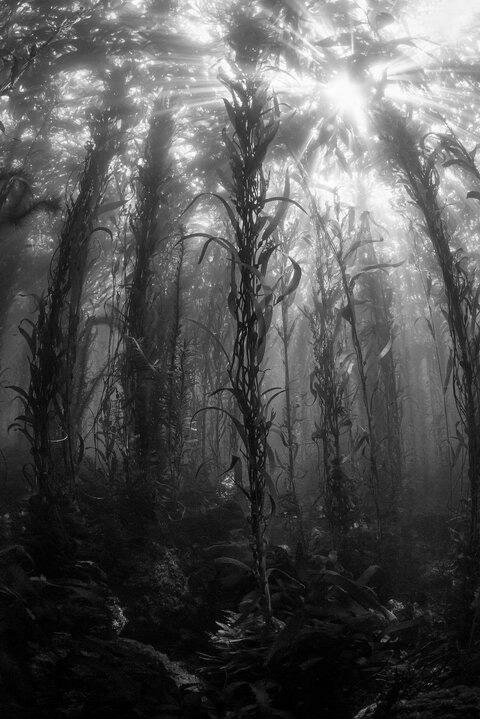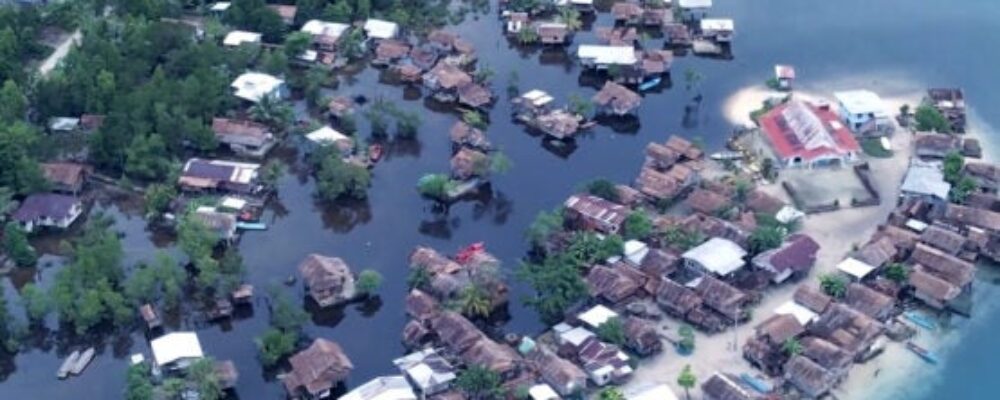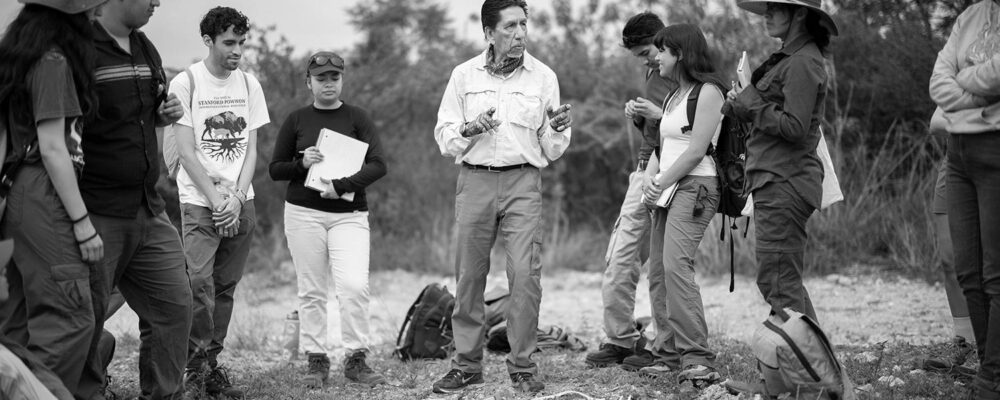Marine heatwaves that seemed extreme just a decade ago will become commonplace by the end of this century in waters favored by giant kelp, researchers have found.
Dense forests of giant kelp absorb carbon dioxide from surface waters and produce oxygen. These underwater forests also provide food and shelter to a rich array of marine species, from anemones and abalone to sea otters and giant sea bass. But huge swaths of kelp forest along the California coast have died off in recent years amid severe marine heatwaves and booming populations of sea urchins, which eat kelp.
A pair of studies from Stanford University scientists suggests restricting fishing within kelp habitats helps the forests recover and makes their ecosystems more resilient to marine heatwaves, which are predicted to become more severe and frequent with climate change.
“,”additional”:{“file_info”:{“file_name”:”kelp.jpg”,”size_readable”:”172.0 KB”,”size_bytes”:176096,”width”:480,”height”:719,”modified_readable”:”Apr 21, 2025 11:49 AM”,”modified_unix”:1745261344},”varieties”:[{“id”:”168946:v1″,”type”:”image_variety”,”type_name”:”Image Variety”,”version”:””,”name”:”100w”,”short_name”:”100w”,”status”:{“id”:16,”code”:”live”,”name”:”Live”},”created”:{“date”:”1969-12-31T16:00:00-08:00″,”user_id”:null},”updated”:{“date”:”1969-12-31T16:00:00-08:00″,”user_id”:null},”published”:{“date”:null,”user_id”:null},”status_changed”:{“date”:”1969-12-31T16:00:00-08:00″,”user_id”:null},”urls”:[“https://news.stanford.edu/__data/assets/image/0034/168946/varieties/100w.jpg”],”url”:”https://news.stanford.edu/__data/assets/image/0034/168946/varieties/100w.jpg”,”attributes”:{“variety_type”:”resize”,”filename”:”100w.jpg”,”name”:”100w”,”title”:”Kelp vertical”,”caption”:”Credit: Mission Blue / Eduardo Sorensen”,”variety_size”:3587,”variety_height”:100,”variety_width”:100,”alt”:”Forest of giant kelp”,”dimension_min”:0,”dimension”:100,”height”:0,”width”:0,”constrain”:”centre_weighted_square”},”metadata”:null,”contents”:””,”additional”:{}},{“id”:”168946:v2″,”type”:”image_variety”,”type_name”:”Image Variety”,”version”:””,”name”:”150w”,”short_name”:”150w”,”status”:{“id”:16,”code”:”live”,”name”:”Live”},”created”:{“date”:”1969-12-31T16:00:00-08:00″,”user_id”:null},”updated”:{“date”:”1969-12-31T16:00:00-08:00″,”user_id”:null},”published”:{“date”:null,”user_id”:null},”status_changed”:{“date”:”1969-12-31T16:00:00-08:00″,”user_id”:null},”urls”:[“https://news.stanford.edu/__data/assets/image/0034/168946/varieties/150w.jpg”],”url”:”https://news.stanford.edu/__data/assets/image/0034/168946/varieties/150w.jpg”,”attributes”:{“variety_type”:”resize”,”filename”:”150w.jpg”,”name”:”150w”,”title”:”Kelp vertical”,”caption”:”Credit: Mission Blue / Eduardo Sorensen”,”variety_size”:6654,”variety_height”:150,”variety_width”:150,”alt”:”Forest of giant kelp”,”dimension_min”:0,”dimension”:150,”height”:0,”width”:0,”constrain”:”centre_weighted_square”},”metadata”:null,”contents”:””,”additional”:{}},{“id”:”168946:v3″,”type”:”image_variety”,”type_name”:”Image Variety”,”version”:””,”name”:”200w”,”short_name”:”200w”,”status”:{“id”:16,”code”:”live”,”name”:”Live”},”created”:{“date”:”1969-12-31T16:00:00-08:00″,”user_id”:null},”updated”:{“date”:”1969-12-31T16:00:00-08:00″,”user_id”:null},”published”:{“date”:null,”user_id”:null},”status_changed”:{“date”:”1969-12-31T16:00:00-08:00″,”user_id”:null},”urls”:[“https://news.stanford.edu/__data/assets/image/0034/168946/varieties/200w.jpg”],”url”:”https://news.stanford.edu/__data/assets/image/0034/168946/varieties/200w.jpg”,”attributes”:{“variety_type”:”resize”,”filename”:”200w.jpg”,”name”:”200w”,”title”:”Kelp vertical”,”caption”:”Credit: Mission Blue / Eduardo Sorensen”,”variety_size”:15233,”variety_height”:300,”variety_width”:200,”alt”:”Forest of giant kelp”,”dimension_min”:0,”dimension”:0,”height”:200,”width”:200,”constrain”:”width”},”metadata”:null,”contents”:””,”additional”:{}},{“id”:”168946:v4″,”type”:”image_variety”,”type_name”:”Image Variety”,”version”:””,”name”:”300w”,”short_name”:”300w”,”status”:{“id”:16,”code”:”live”,”name”:”Live”},”created”:{“date”:”1969-12-31T16:00:00-08:00″,”user_id”:null},”updated”:{“date”:”1969-12-31T16:00:00-08:00″,”user_id”:null},”published”:{“date”:null,”user_id”:null},”status_changed”:{“date”:”1969-12-31T16:00:00-08:00″,”user_id”:null},”urls”:[“https://news.stanford.edu/__data/assets/image/0034/168946/varieties/300w.jpg”],”url”:”https://news.stanford.edu/__data/assets/image/0034/168946/varieties/300w.jpg”,”attributes”:{“variety_type”:”resize”,”filename”:”300w.jpg”,”name”:”300w”,”title”:”Kelp vertical”,”caption”:”Credit: Mission Blue / Eduardo Sorensen”,”variety_size”:15233,”variety_height”:300,”variety_width”:200,”alt”:”Forest of giant kelp”,”dimension_min”:0,”dimension”:0,”height”:300,”width”:200,”constrain”:”width”},”metadata”:null,”contents”:””,”additional”:{}},{“id”:”168946:v5″,”type”:”image_variety”,”type_name”:”Image Variety”,”version”:””,”name”:”345w”,”short_name”:”345w”,”status”:{“id”:16,”code”:”live”,”name”:”Live”},”created”:{“date”:”1969-12-31T16:00:00-08:00″,”user_id”:null},”updated”:{“date”:”1969-12-31T16:00:00-08:00″,”user_id”:null},”published”:{“date”:null,”user_id”:null},”status_changed”:{“date”:”1969-12-31T16:00:00-08:00″,”user_id”:null},”urls”:[“https://news.stanford.edu/__data/assets/image/0034/168946/varieties/345w.jpg”],”url”:”https://news.stanford.edu/__data/assets/image/0034/168946/varieties/345w.jpg”,”attributes”:{“variety_type”:”resize”,”filename”:”345w.jpg”,”name”:”345w”,”title”:”Kelp vertical”,”caption”:”Credit: Mission Blue / Eduardo Sorensen”,”variety_size”:39819,”variety_height”:517,”variety_width”:345,”alt”:”Forest of giant kelp”,”dimension_min”:0,”dimension”:0,”height”:555,”width”:345,”constrain”:”width”},”metadata”:null,”contents”:””,”additional”:{}},{“id”:”168946:v6″,”type”:”image_variety”,”type_name”:”Image Variety”,”version”:””,”name”:”375w”,”short_name”:”375w”,”status”:{“id”:16,”code”:”live”,”name”:”Live”},”created”:{“date”:”1969-12-31T16:00:00-08:00″,”user_id”:null},”updated”:{“date”:”1969-12-31T16:00:00-08:00″,”user_id”:null},”published”:{“date”:null,”user_id”:null},”status_changed”:{“date”:”1969-12-31T16:00:00-08:00″,”user_id”:null},”urls”:[“https://news.stanford.edu/__data/assets/image/0034/168946/varieties/375w.jpg”],”url”:”https://news.stanford.edu/__data/assets/image/0034/168946/varieties/375w.jpg”,”attributes”:{“variety_type”:”resize”,”filename”:”375w.jpg”,”name”:”375w”,”title”:”Kelp vertical”,”caption”:”Credit: Mission Blue / Eduardo Sorensen”,”variety_size”:45987,”variety_height”:562,”variety_width”:375,”alt”:”Forest of giant kelp”,”dimension_min”:0,”dimension”:0,”height”:200,”width”:375,”constrain”:”width”},”metadata”:null,”contents”:””,”additional”:{}},{“id”:”168946:v7″,”type”:”image_variety”,”type_name”:”Image Variety”,”version”:””,”name”:”400w”,”short_name”:”400w”,”status”:{“id”:16,”code”:”live”,”name”:”Live”},”created”:{“date”:”1969-12-31T16:00:00-08:00″,”user_id”:null},”updated”:{“date”:”1969-12-31T16:00:00-08:00″,”user_id”:null},”published”:{“date”:null,”user_id”:null},”status_changed”:{“date”:”1969-12-31T16:00:00-08:00″,”user_id”:null},”urls”:[“https://news.stanford.edu/__data/assets/image/0034/168946/varieties/400w.jpg”],”url”:”https://news.stanford.edu/__data/assets/image/0034/168946/varieties/400w.jpg”,”attributes”:{“variety_type”:”resize”,”filename”:”400w.jpg”,”name”:”400w”,”title”:”Kelp vertical”,”caption”:”Credit: Mission Blue / Eduardo Sorensen”,”variety_size”:51178,”variety_height”:599,”variety_width”:400,”alt”:”Forest of giant kelp”,”dimension_min”:0,”dimension”:0,”height”:100,”width”:400,”constrain”:”width”},”metadata”:null,”contents”:””,”additional”:{}},{“id”:”168946:v8″,”type”:”image_variety”,”type_name”:”Image Variety”,”version”:””,”name”:”555w”,”short_name”:”555w”,”status”:{“id”:16,”code”:”live”,”name”:”Live”},”created”:{“date”:”1969-12-31T16:00:00-08:00″,”user_id”:null},”updated”:{“date”:”1969-12-31T16:00:00-08:00″,”user_id”:null},”published”:{“date”:null,”user_id”:null},”status_changed”:{“date”:”1969-12-31T16:00:00-08:00″,”user_id”:null},”urls”:[“https://news.stanford.edu/__data/assets/image/0034/168946/varieties/555w.jpg”],”url”:”https://news.stanford.edu/__data/assets/image/0034/168946/varieties/555w.jpg”,”attributes”:{“variety_type”:”resize”,”filename”:”555w.jpg”,”name”:”555w”,”title”:”Kelp vertical”,”caption”:”Credit: Mission Blue / Eduardo Sorensen”,”variety_size”:90081,”variety_height”:831,”variety_width”:555,”alt”:”Forest of giant kelp”,”dimension_min”:0,”dimension”:0,”height”:0,”width”:555,”constrain”:”width”},”metadata”:null,”contents”:””,”additional”:{}},{“id”:”168946:v9″,”type”:”image_variety”,”type_name”:”Image Variety”,”version”:””,”name”:”600w”,”short_name”:”600w”,”status”:{“id”:16,”code”:”live”,”name”:”Live”},”created”:{“date”:”1969-12-31T16:00:00-08:00″,”user_id”:null},”updated”:{“date”:”1969-12-31T16:00:00-08:00″,”user_id”:null},”published”:{“date”:null,”user_id”:null},”status_changed”:{“date”:”1969-12-31T16:00:00-08:00″,”user_id”:null},”urls”:[“https://news.stanford.edu/__data/assets/image/0034/168946/varieties/600w.jpg”],”url”:”https://news.stanford.edu/__data/assets/image/0034/168946/varieties/600w.jpg”,”attributes”:{“variety_type”:”resize”,”filename”:”600w.jpg”,”name”:”600w”,”title”:”Kelp vertical”,”caption”:”Credit: Mission Blue / Eduardo Sorensen”,”variety_size”:103320,”variety_height”:899,”variety_width”:600,”alt”:”Forest of giant kelp”,”dimension_min”:0,”dimension”:0,”height”:0,”width”:600,”constrain”:”width”},”metadata”:null,”contents”:””,”additional”:{}},{“id”:”168946:v10″,”type”:”image_variety”,”type_name”:”Image Variety”,”version”:””,”name”:”690w”,”short_name”:”690w”,”status”:{“id”:16,”code”:”live”,”name”:”Live”},”created”:{“date”:”1969-12-31T16:00:00-08:00″,”user_id”:null},”updated”:{“date”:”1969-12-31T16:00:00-08:00″,”user_id”:null},”published”:{“date”:null,”user_id”:null},”status_changed”:{“date”:”1969-12-31T16:00:00-08:00″,”user_id”:null},”urls”:[“https://news.stanford.edu/__data/assets/image/0034/168946/varieties/690w.jpg”],”url”:”https://news.stanford.edu/__data/assets/image/0034/168946/varieties/690w.jpg”,”attributes”:{“variety_type”:”resize”,”filename”:”690w.jpg”,”name”:”690w”,”title”:”Kelp vertical”,”caption”:”Credit: Mission Blue / Eduardo Sorensen”,”variety_size”:130008,”variety_height”:1034,”variety_width”:690,”alt”:”Forest of giant kelp”,”dimension_min”:0,”dimension”:0,”height”:0,”width”:690,”constrain”:”width”},”metadata”:null,”contents”:””,”additional”:{}},{“id”:”168946:v11″,”type”:”image_variety”,”type_name”:”Image Variety”,”version”:””,”name”:”705w”,”short_name”:”705w”,”status”:{“id”:16,”code”:”live”,”name”:”Live”},”created”:{“date”:”1969-12-31T16:00:00-08:00″,”user_id”:null},”updated”:{“date”:”1969-12-31T16:00:00-08:00″,”user_id”:null},”published”:{“date”:null,”user_id”:null},”status_changed”:{“date”:”1969-12-31T16:00:00-08:00″,”user_id”:null},”urls”:[“https://news.stanford.edu/__data/assets/image/0034/168946/varieties/705w.jpg”],”url”:”https://news.stanford.edu/__data/assets/image/0034/168946/varieties/705w.jpg”,”attributes”:{“variety_type”:”resize”,”filename”:”705w.jpg”,”name”:”705w”,”title”:”Kelp vertical”,”caption”:”Credit: Mission Blue / Eduardo Sorensen”,”variety_size”:134439,”variety_height”:1056,”variety_width”:705,”alt”:”Forest of giant kelp”,”dimension_min”:0,”dimension”:0,”height”:0,”width”:705,”constrain”:”width”},”metadata”:null,”contents”:””,”additional”:{}},{“id”:”168946:v12″,”type”:”image_variety”,”type_name”:”Image Variety”,”version”:””,”name”:”750w”,”short_name”:”750w”,”status”:{“id”:16,”code”:”live”,”name”:”Live”},”created”:{“date”:”1969-12-31T16:00:00-08:00″,”user_id”:null},”updated”:{“date”:”1969-12-31T16:00:00-08:00″,”user_id”:null},”published”:{“date”:null,”user_id”:null},”status_changed”:{“date”:”1969-12-31T16:00:00-08:00″,”user_id”:null},”urls”:[“https://news.stanford.edu/__data/assets/image/0034/168946/varieties/750w.jpg”],”url”:”https://news.stanford.edu/__data/assets/image/0034/168946/varieties/750w.jpg”,”attributes”:{“variety_type”:”resize”,”filename”:”750w.jpg”,”name”:”750w”,”title”:”Kelp vertical”,”caption”:”Credit: Mission Blue / Eduardo Sorensen”,”variety_size”:148284,”variety_height”:1123,”variety_width”:750,”alt”:”Forest of giant kelp”,”dimension_min”:0,”dimension”:0,”height”:0,”width”:750,”constrain”:”width”},”metadata”:null,”contents”:””,”additional”:{}},{“id”:”168946:v13″,”type”:”image_variety”,”type_name”:”Image Variety”,”version”:””,”name”:”795w”,”short_name”:”795w”,”status”:{“id”:16,”code”:”live”,”name”:”Live”},”created”:{“date”:”1969-12-31T16:00:00-08:00″,”user_id”:null},”updated”:{“date”:”1969-12-31T16:00:00-08:00″,”user_id”:null},”published”:{“date”:null,”user_id”:null},”status_changed”:{“date”:”1969-12-31T16:00:00-08:00″,”user_id”:null},”urls”:[“https://news.stanford.edu/__data/assets/image/0034/168946/varieties/795w.jpg”],”url”:”https://news.stanford.edu/__data/assets/image/0034/168946/varieties/795w.jpg”,”attributes”:{“variety_type”:”resize”,”filename”:”795w.jpg”,”name”:”795w”,”title”:”Kelp vertical”,”caption”:”Credit: Mission Blue / Eduardo Sorensen”,”variety_size”:163483,”variety_height”:1191,”variety_width”:795,”alt”:”Forest of giant kelp”,”dimension_min”:0,”dimension”:0,”height”:0,”width”:795,”constrain”:”width”},”metadata”:null,”contents”:””,”additional”:{}},{“id”:”168946:v14″,”type”:”image_variety”,”type_name”:”Image Variety”,”version”:””,”name”:”960w”,”short_name”:”960w”,”status”:{“id”:16,”code”:”live”,”name”:”Live”},”created”:{“date”:”1969-12-31T16:00:00-08:00″,”user_id”:null},”updated”:{“date”:”1969-12-31T16:00:00-08:00″,”user_id”:null},”published”:{“date”:null,”user_id”:null},”status_changed”:{“date”:”1969-12-31T16:00:00-08:00″,”user_id”:null},”urls”:[“https://news.stanford.edu/__data/assets/image/0034/168946/varieties/960w.jpg”],”url”:”https://news.stanford.edu/__data/assets/image/0034/168946/varieties/960w.jpg”,”attributes”:{“variety_type”:”resize”,”filename”:”960w.jpg”,”name”:”960w”,”title”:”Kelp vertical”,”caption”:”Credit: Mission Blue / Eduardo Sorensen”,”variety_size”:231934,”variety_height”:1438,”variety_width”:960,”alt”:”Forest of giant kelp”,”dimension_min”:0,”dimension”:0,”height”:0,”width”:960,”constrain”:”width”},”metadata”:null,”contents”:””,”additional”:{}},{“id”:”168946:v15″,”type”:”image_variety”,”type_name”:”Image Variety”,”version”:””,”name”:”1024w”,”short_name”:”1024w”,”status”:{“id”:16,”code”:”live”,”name”:”Live”},”created”:{“date”:”1969-12-31T16:00:00-08:00″,”user_id”:null},”updated”:{“date”:”1969-12-31T16:00:00-08:00″,”user_id”:null},”published”:{“date”:null,”user_id”:null},”status_changed”:{“date”:”1969-12-31T16:00:00-08:00″,”user_id”:null},”urls”:[“https://news.stanford.edu/__data/assets/image/0034/168946/varieties/1024w.jpg”],”url”:”https://news.stanford.edu/__data/assets/image/0034/168946/varieties/1024w.jpg”,”attributes”:{“variety_type”:”resize”,”filename”:”1024w.jpg”,”name”:”1024w”,”title”:”Kelp vertical”,”caption”:”Credit: Mission Blue / Eduardo Sorensen”,”variety_size”:244889,”variety_height”:1534,”variety_width”:1024,”alt”:”Forest of giant kelp”,”dimension_min”:0,”dimension”:0,”height”:0,”width”:1024,”constrain”:”width”},”metadata”:null,”contents”:””,”additional”:{}},{“id”:”168946:v16″,”type”:”image_variety”,”type_name”:”Image Variety”,”version”:””,”name”:”1110w”,”short_name”:”1110w”,”status”:{“id”:16,”code”:”live”,”name”:”Live”},”created”:{“date”:”1969-12-31T16:00:00-08:00″,”user_id”:null},”updated”:{“date”:”1969-12-31T16:00:00-08:00″,”user_id”:null},”published”:{“date”:null,”user_id”:null},”status_changed”:{“date”:”1969-12-31T16:00:00-08:00″,”user_id”:null},”urls”:[“https://news.stanford.edu/__data/assets/image/0034/168946/varieties/1110w.jpg”],”url”:”https://news.stanford.edu/__data/assets/image/0034/168946/varieties/1110w.jpg”,”attributes”:{“variety_type”:”resize”,”filename”:”1110w.jpg”,”name”:”1110w”,”title”:”Kelp vertical”,”caption”:”Credit: Mission Blue / Eduardo Sorensen”,”variety_size”:281290,”variety_height”:1663,”variety_width”:1110,”alt”:”Forest of giant kelp”,”dimension_min”:0,”dimension”:0,”height”:0,”width”:1110,”constrain”:”width”},”metadata”:null,”contents”:””,”additional”:{}},{“id”:”168946:v17″,”type”:”image_variety”,”type_name”:”Image Variety”,”version”:””,”name”:”1410w”,”short_name”:”1410w”,”status”:{“id”:16,”code”:”live”,”name”:”Live”},”created”:{“date”:”1969-12-31T16:00:00-08:00″,”user_id”:null},”updated”:{“date”:”1969-12-31T16:00:00-08:00″,”user_id”:null},”published”:{“date”:null,”user_id”:null},”status_changed”:{“date”:”1969-12-31T16:00:00-08:00″,”user_id”:null},”urls”:[“https://news.stanford.edu/__data/assets/image/0034/168946/varieties/1410w.jpg”],”url”:”https://news.stanford.edu/__data/assets/image/0034/168946/varieties/1410w.jpg”,”attributes”:{“variety_type”:”resize”,”filename”:”1410w.jpg”,”name”:”1410w”,”title”:”Kelp vertical”,”caption”:”Credit: Mission Blue / Eduardo Sorensen”,”variety_size”:416392,”variety_height”:2112,”variety_width”:1410,”alt”:”Forest of giant kelp”,”dimension_min”:0,”dimension”:0,”height”:0,”width”:1410,”constrain”:”width”},”metadata”:null,”contents”:””,”additional”:{}},{“id”:”168946:v18″,”type”:”image_variety”,”type_name”:”Image Variety”,”version”:””,”name”:”1500w”,”short_name”:”1500w”,”status”:{“id”:16,”code”:”live”,”name”:”Live”},”created”:{“date”:”1969-12-31T16:00:00-08:00″,”user_id”:null},”updated”:{“date”:”1969-12-31T16:00:00-08:00″,”user_id”:null},”published”:{“date”:null,”user_id”:null},”status_changed”:{“date”:”1969-12-31T16:00:00-08:00″,”user_id”:null},”urls”:[“https://news.stanford.edu/__data/assets/image/0034/168946/varieties/1500w.jpg”],”url”:”https://news.stanford.edu/__data/assets/image/0034/168946/varieties/1500w.jpg”,”attributes”:{“variety_type”:”resize”,”filename”:”1500w.jpg”,”name”:”1500w”,”title”:”Kelp vertical”,”caption”:”Credit: Mission Blue / Eduardo Sorensen”,”variety_size”:461839,”variety_height”:2247,”variety_width”:1500,”alt”:”Forest of giant kelp”,”dimension_min”:0,”dimension”:0,”height”:0,”width”:1500,”constrain”:”width”},”metadata”:null,”contents”:””,”additional”:{}}],”exif”:{“image”:{“ImageHeight”:719,”ImageWidth”:480,”ModifyDate”:”2025:04:21 11:43:34″,”Orientation”:0,”ResolutionUnit”:0,”Software”:”Adobe Photoshop 26.1 (Macintosh)”,”XResolution”:72,”YResolution”:72},”thumbnail”:{“Compression”:0,”ThumbnailLength”:5877,”ThumbnailOffset”:398},”exif”:{“ColorSpace”:0,”CreateDate”:”2025:04:21 11:40:59-07:00″,”ExifImageHeight”:719,”ExifImageWidth”:480}}}}}”>
Dense forests of giant kelp absorb carbon dioxide from surface waters and produce oxygen, while providing food and shelter to a rich array of marine species. | Mission Blue / Eduardo Sorensen
The fishing bans in protected areas allowed predator species like California sheephead and spiny lobster, which are targeted by commercial fishers, to thrive and control populations of prey species, including sea urchins. “Urchins eat kelp, so preserving their predators indirectly promotes kelp growth,” said lead study author Joy Kumagai, a PhD student in biology in Stanford’s School of Humanities and Sciences.
The research expands on studies over the past decade showing that resurgent populations of sea otters on the central California coast have helped kelp forests withstand environmental threats and recover from overgrazing by eating urchins and shellfish. But sea otters, which ranged south as far as Baja California before the rise of the maritime fur trade, are no longer present in southern California waters. “In southern California, the two species that eat large adult urchins are fished,” Kumagai said.
The most important insight from the new research, she added, is that prohibiting fishing from certain coastal areas enables kelp forests to withstand extreme temperatures by preserving or restoring “trophic cascades,” meaning the indirect impacts of predators.
Kumagai and colleagues focused their study on a period when one of the worst marine heatwaves on record swept over the eastern Pacific Ocean, with surface temperatures reaching up to 4 degrees Celsius above the historical average.
“This analysis provides robust evidence that protecting marine predators promotes the recovery of marine forests even in the face of prolonged marine heatwaves that have damaged ecosystems all along the California coast,” said co-senior author Fiorenza Micheli, professor of oceans in the Stanford Doerr School of Sustainability and co-director of the Stanford Center for Ocean Solutions.
The new evidence can inform discussions around managing and establishing marine protected areas as part of a commitment by 190 countries to protect 30% of Earth’s land and ocean area by 2030. The research shows that “preserving intact food webs matters, but effects take time and require large-scale protection, as well as extensive long-term monitoring to detect ecological benefits,” said senior study author Nur Arafeh-Dalmau, a postdoctoral scholar in Stanford’s Oceans Department.
An ability to withstand prolonged marine heatwaves is likely to become more important for kelp forests’ survival in the future. In a second study, published April 3 in Nature Communications and led by Arafeh-Dalmau, scientists predict that the intensity of marine heatwaves in kelp forest habitats around the world will roughly double by 2040 compared to the present average – regardless of how much or how little humanity reins in emissions of planet-warming gases.
The new findings are based on analyses of global climate models and a first-of-its-kind map of kelp forest habitats created using satellite remote-sensing data.
In a scenario where humanity sharply curtails its carbon dioxide emissions before midcentury, the researchers predict heatwave intensity in kelp forest habitats will still more than quintuple by 2100. Under all climate scenarios, kelp habitats in the Arctic and temperate waters of the northern Pacific Ocean are projected to experience the most frequent heatwaves. However, some regions in the Southern Hemisphere such as Patagonia will be less exposed to extreme temperatures and may provide what scientists call “climate refugia,” or critical havens where kelp forests can persist in spite of global warming.
In scenarios where humanity continues adding more carbon dioxide to Earth’s atmosphere over the next several decades, the researchers predict heatwaves in kelp forest areas could intensify up to 16-fold by 2100.
The researchers also examined the level of fishing activity allowed in kelp forest habitats around the world. They found that globally, governments have established marine protected areas with fishing bans in 13.7% of kelp forest habitats, mostly around remote islands in the Southern Ocean – while fishing is allowed with some restrictions in 14.8% of kelp forest habitats. With only 2.8% of kelp forests fully protected in waters excluding remote island areas, the results suggest that kelp forests closer to continental shores need more protections against fishing impacts, Arafeh-Dalmau said.
Among all ecoregions projected to have kelp forest habitats highly threatened by marine heatwaves, only the stretch of California that runs from the San Francisco Bay Area south to the U.S.-Mexico border has fishing bans in place for at least 10% of the kelp habitat. “The network of marine protected areas in California is a global model of marine biodiversity conservation,” Micheli said.






